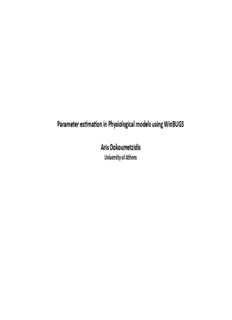
Parameter es*ma*on in Physiological models using WinBUGS Aris PDF
Preview Parameter es*ma*on in Physiological models using WinBUGS Aris
Parameter es)ma)on in Physiological models using WinBUGS Aris Dokoumetzidis University of Athens Structure 1. Introduc)on and the basics of WinBUGS • Introduc*on to WinBUGS • Familiarisa*on with the interface • Winbugs language: models, priors, ini*al values • Running Winbugs and the format of the results • Chain convergence and diagnos*cs • Running a simple BUGS mode 2. FiEng models to kine)c data • Running a pharmacokine*c model • Using scripts and interfacing WinBugs from other programmes • FiCng ODE models to data Structure 3. Hierarchical models • FiCng popula*on models to kine*c data • Descrip*ve covariates • Mul*‐level hierarchical models 4. Informa)ve Priors • Defining informa*ve priors from previous WinBUGS runs • Defining informa*ve priors from literature 6. Model comparison WinBUGS BUGS: Bayesian inference Using Gibbs Sampling A computer programme to perform Bayesian inference of parametric models using Markov Chain Monte Carlo (MCMC) method. Different versions: WinBUGS, OpenBUGS (same but open source), Unix command line based versions. Can be run on Linux and Mac through WINE Also interfaces from Matlab, S‐Plus, R and other Winbugs developed on a plaTorm called Blackbox (Omeron, Switzerland) using a language called Component Pascal which is a non‐ANSI Pascal dialect. MCMC Markov Chain Monte Carlo method creates random samples such that aVer enough itera*ons the chain converges to a sta*onary distribu*on which is the joint distribu*on of all stochas*c parameters. (Markov chain is a series of states with memory 1, i.e. each state depends only on the previous step) Gibbs sampling: The chain is updated by sampling, for each variable, from its full condi*onal distribu*on where all other variables are considered known and are given the values of the previous state of the chain. Metropolis – Has)ngs: Used when the distribu*on is not of known form like in nonlinear systems. For each variable a new value is generated from a proposal distribu*on which is then compared with the old value. The new value is accepted with a probability so that the draws are actually simula*ng from the posterior distribu*on. If a value is rejected then the variable retains its old value. WinBUGS interface Running WinBUGS • Fit parametric models to data and obtain parameter es*mates • Parameter es*mates typically are point es*mates and uncertainty • In WinBUGS the output is a chain of samples from a nonparametric distribu*on represen*ng the posterior distribu*on • With descrip*ve sta*s*cs on the chains, meaningful output is calculated • Also being Bayesian one has to set priors in the form of parametric distribu*ons Running WinBUGS BUGS model model { for (i in 1:n.ind) { for (j in ... Priors y t si n e d . b ro run model posteriors p value Data n o * a r t n e c n o c *me Ini*al values WinBUGS Language Used to define the model and the priors. Not really a full featured programming language Can do: • Assignments of variables. So called logical nodes: a <- b • Defini*on of stochas*c variables (nodes): a ~ dnorm(mu,tau) • For‐loops: for( i in 1:N ) { <commands> } • Evaluate algebraic formulas (but big ones are slow, these need to be hardcoded and be called as func*ons): a <- b + (exp(d) – 1) • No “if” statement but a “step” func*on can poten*ally serve the “if“ func*onality for certain cases. e.g. to define branched expressions • Supports indices and tables: x[i, j, k] or y[1:5, 1:5] or z[] means all values of z and z[,3] means the 3rd column • A defini*on of the data as a stochas*c node is always present Data Data in WinBUGS are inserted as mul*dimensional matrices or vectors in 2 formats Rectangular array a[] b[] 1 1.2 2 1.6 3 0.12 END S‐Plus format list( a = c(1, 2, 3), b = c(1.2, 1.6, 0.12), m = structure(.Data=c(1,2,3,4,5,6,NA,8,9),.Dim=c(3, 3)) )
Description: